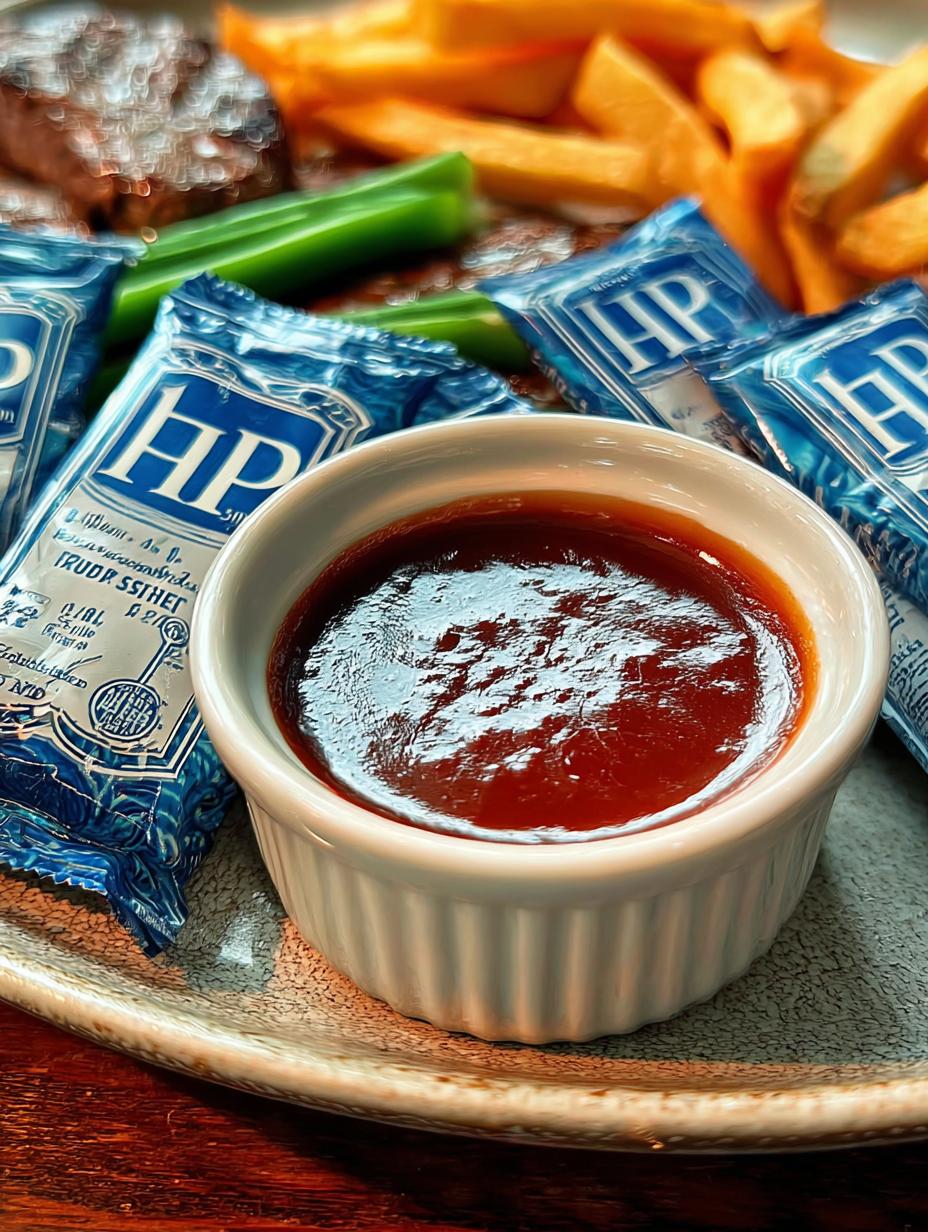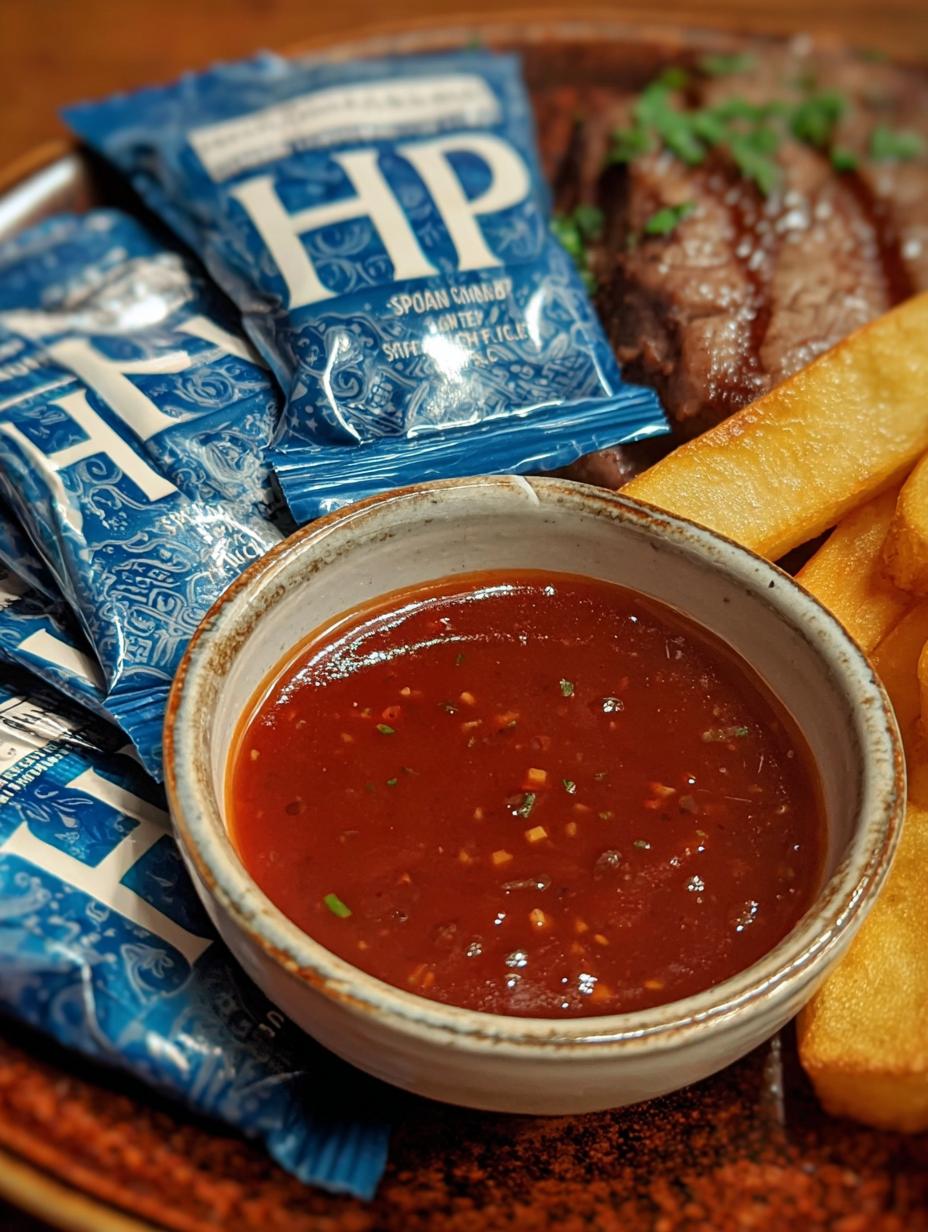Table of Contents
Sauce has a way of transforming a meal from ordinary to extraordinary, and few condiments hold the iconic status of HP Sauce. This quintessential British Sauce is a beloved staple in kitchens across the UK, instantly recognizable for its unique tangy, mildly spicy, and deeply savory flavor profile. I remember the first time I tried it on a simple bacon sandwich; it was a revelation! Its versatility is astounding, elevating everything from hearty meat and potato dishes to crispy fish and chips and humble sandwiches. If you’re looking to add a punch of flavor to your meals, understanding HP Sauce is a great starting point for exploring delicious sauce recipes. Let’s dive into what makes this brown sauce so special!
What Exactly is HP Sauce? Exploring its Unique Profile
So, what exactly is Sauce? HP Sauce is a specific type of brown sauce, a truly iconic condiment in British cuisine. Its flavor profile is wonderfully distinctive – a complex blend that’s tangy, slightly sweet, and offers a gentle kick of spice. Unlike a simple tomato-based sauce, its unique taste comes from a carefully balanced mix of key sauce ingredients. It’s this unique character that sets it apart and makes it such a beloved part of many meals. Understanding its composition is key to appreciating why it’s considered a superior sauce base for so many dishes.

The Heart of the Flavor: Key Sauce Ingredients
The magic of HP Sauce truly lies in its carefully selected sauce ingredients. At its core are ripe tomatoes, providing a rich base. Then comes the zing from malt vinegar, which gives it that signature tang. For a deep, dark sweetness, molasses is added, a crucial component in the sauce making guide for many traditional recipes. The exotic note of tamarind contributes another layer of complexity, adding a fruity tartness. Finally, a secret blend of spices ties it all together, creating that unmistakable and addictive flavor profile that makes HP Sauce so special. You can learn more about the history of condiments and their ingredients.
A Saucy History: The Story Behind HP Sauce
Every great condiment has a story, and HP Sauce is no exception! This beloved sauce was invented way back in 1899 by Frederick Gibson Garton. He was inspired by the Houses of Parliament, which were visible from his shop, and so the brand name “HP” was born, standing for Houses of Parliament. It quickly became a symbol of British culinary history. Its enduring popularity in the UK is a testament to its unique flavor and the rich sauce history behind it. Understanding this context helps explain why it’s such a staple compared to other different types of sauces. For more on British food history, you might explore resources on traditional British recipes.
How to Enjoy HP Sauce: Classic Pairings and Simple Sauce Ideas
Now that we know a bit about its history and ingredients, let’s talk about the best part: enjoying HP Sauce! This isn’t a sauce you typically need to learn how to make sauce for, as its perfection is already bottled. For a truly authentic British experience, HP Sauce is the ultimate condiment for hearty dishes. It’s the classic sauce for steak, especially a perfectly cooked pie or a juicy grilled cut. Don’t forget its legendary pairing with “bangers and mash” (sausages and mashed potatoes) and savory potato scones.
Fish and chips just aren’t complete without a generous dollop of HP Sauce. It adds a fantastic tangy counterpoint to the crispy batter and flaky fish. And for those who adore a good sandwich, a bacon butty (a bacon sandwich) is elevated to new heights with a smear of this iconic brown sauce. Many people consider it an absolute must-have for their fries, transforming a simple side into something truly special. While it’s famously paired with savory items, you might be surprised by how well it works in some simple sauce ideas for other dishes, offering a unique flavor kick. You can find more recipes that might incorporate similar flavor profiles.

While it’s not typically used as a base for cooking, its robust flavor can enhance marinades. Think about a light glaze for grilled chicken or pork – just a touch can add incredible depth. This versatile condiment offers a quick way to add complex flavor without any extra cooking. Its readiness means you can instantly upgrade almost any savory meal, making it a true kitchen hero. Exploring these pairings is a delicious journey into British culinary traditions. For those interested in food safety and storage, understanding terms of use for food products is important.
Beyond the Basics: Exploring Sauce Variations
While the original HP Sauce is a classic for a reason, the brand offers some exciting sauce variations that are worth exploring. You might find HP Fruity Sauce, which offers a sweeter, less tangy profile, often with a hint of apple. Then there’s HP Barbecue Sauce, bringing a smoky, robust flavor perfect for grilling. When trying these, remember that international versions of HP Sauce can sometimes taste quite different from those found in the UK. For the authentic experience, I always recommend seeking out the original version, preferably one made in the Netherlands, as it tends to be closer to the classic taste. These variations offer different ways to enjoy the HP flavor, fitting into various best sauce recipes and meal ideas.
Sauce Cooking Tips: Making the Most of Your Condiment
To truly appreciate HP Sauce, a few sauce cooking tips can go a long way. First and foremost, always check the origin. As I mentioned, versions made in North America can have a significantly different flavor profile, often due to the use of high fructose corn syrup instead of molasses and different spice blends. Many fans consider these North American versions inferior and not true representations of the original. If you’re conscious about ingredients, be aware that the sauce does contain high fructose corn syrup, which might be a concern for some. Using it as a finishing sauce or a dip, rather than a primary cooking ingredient, often allows its unique flavors to shine brightest as a sauce flavor enhancer without being overpowering. For more information on ingredient sourcing and consumer rights, you can review our GDPR policy.
Frequently Asked Questions About HP Sauce
I get a lot of questions about this iconic British condiment, so let’s clear a few things up! Many people wonder if HP Sauce is suitable for vegetarians. The good news is, yes, it is! It’s a fantastic option for those looking for flavorful sauce recipes without meat products. While some might compare it to A1 Steak Sauce, I find HP Sauce to be in a league of its own. Many agree that its complex tangy and spicy profile offers a superior taste and texture compared to A1, making it a preferred choice for many.
Is HP Sauce vegetarian?
Absolutely! HP Sauce is proudly vegetarian, making it a versatile condiment for a wide range of dishes and dietary preferences. It’s a great addition to many vegetarian meals and fits well into various homemade sauce recipes that don’t require meat.
What’s the difference between HP Sauce and A1 Steak Sauce?
While both are brown sauces often used with steak, HP Sauce is generally considered to have a more complex and nuanced flavor profile. Many enthusiasts find its blend of tanginess, sweetness, and spice to be more refined and enjoyable than A1 Steak Sauce, which can sometimes be perceived as harsher or less balanced in comparison.
Where is HP Sauce made?
For the most authentic taste, I always recommend looking for HP Sauce made in the Netherlands. While it’s produced in various locations, the Dutch-made version is often cited as having the closest flavor to the original recipe that many people grew up with and love. If you have further questions, feel free to contact us.
How should I store HP Sauce?
Once opened, it’s best to store HP Sauce in the refrigerator. This helps maintain its freshness and unique flavor profile. Just pop the cap back on tightly and keep it chilled until its next use.
Nutritional Snapshot: Understanding HP Sauce Content
Let’s take a quick look at the nutritional makeup of this classic sauce. Understanding the sauce ingredients can help you incorporate it wisely into your diet. Remember, these are approximate values per serving, which is typically about 1 tablespoon (around 15g).
- Calories: Approx. 15-20
- Sugar: Approx. 3-4g
- Sodium: Approx. 150-200mg
- Fat: 0g
- Saturated Fat: 0g
- Unsaturated Fat: 0g
- Trans Fat: 0g
- Carbohydrates: Approx. 4-5g
- Fiber: 0g
- Protein: 0g
- Cholesterol: 0mg
Nutritional values are estimates and can vary based on specific formulations and serving sizes. For more details on our data practices, please see our privacy policy.
Print
Sauce: 1 Historic British Condiment’s Tasty Ride
- Total Time: 0 minutes
- Yield: N/A
- Diet: Vegetarian
Description
HP Sauce is a popular British brown sauce known for its unique tangy and slightly spicy flavor. It’s a versatile condiment often paired with meat and potato dishes, fish and chips, and sandwiches. Discover its history, ingredients, and how to enjoy this iconic sauce.
Ingredients
- Tomatoes
- Malt vinegar
- Molasses
- Tamarind
- Spices
Instructions
- Understand that HP Sauce is a type of brown sauce originating from the United Kingdom.
- Note its distinct flavor profile, which is a blend of tanginess and mild spice.
- Recognize its common pairings, such as steak pie, bangers and mash, potato scones, and bacon butties.
- Consider it a must-have condiment for chips (fries).
- Be aware of variations like HP Fruity Sauce and HP Barbecue Sauce.
- Learn about the origin of the name ‘HP’, standing for Houses of Parliament.
- Appreciate its historical context, invented by Frederick Gibson Garton in 1899.
- Understand its current ownership by Kraft/Heinz and production location.
- Be informed about the significant sales volume in the UK, indicating its popularity.
- Consider the Royal Warrant of Appointment, signifying approval by the British Royals.
- Explore the wide range of British dishes that are traditionally served with HP Sauce.
- Be cautious of different versions sold internationally; opt for the ‘original’ version, preferably made in the Netherlands.
Notes
- HP Sauce should not be confused with A1 Steak Sauce; it is considered superior in taste and texture by many.
- Versions made in North America are generally not recommended due to significant flavor differences.
- The sauce contains high fructose corn syrup, which may be a concern for some consumers.
- Prep Time: 0 minutes
- Cook Time: 0 minutes
- Category: Condiment
- Method: N/A
- Cuisine: British
Nutrition
- Serving Size: 1 tbsp (approx. 15g)
- Calories: Approx. 15-20
- Sugar: Approx. 3-4g
- Sodium: Approx. 150-200mg
- Fat: 0g
- Saturated Fat: 0g
- Unsaturated Fat: 0g
- Trans Fat: 0g
- Carbohydrates: Approx. 4-5g
- Fiber: 0g
- Protein: 0g
- Cholesterol: 0mg
Keywords: HP Sauce, Brown Sauce, British Sauce, Condiment, Sauce Recipes, Sauce Ingredients, How to Use Sauce, Sauce History
